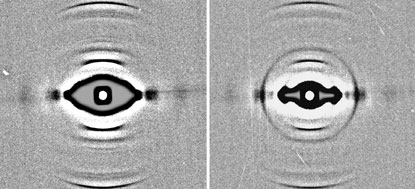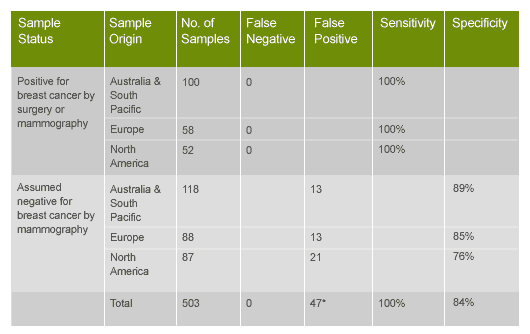Our Development
Bio Farmag's Technology
The breakthrough technology that underpins Bio Farmag’s objectives in bringing revolutionary diagnostics to the market, is the discovery by an Australian scientist that breast cancer can be detected by X-ray diffraction of hair.
This work was first published in the prestigious scientific journal Nature in 1999 (vol. 398: 33-34), in a paper entitled "Using hair to screen for breast cancer." To purchase the full article click here.
In the excerpt (on the left) from the paper, and in the X-ray diffraction patterns below, the finding and its potential is described.
In 1999 a report published in Nature suggested breast cancer could be diagnosed by x-ray diffraction of hair using synchrotron radiation. |
|||
 |
|||
X-ray diffraction pattern of a hair from an individual without breast cancer. |
X-ray diffraction pattern of a hair from an individual with breast cancer. |
||
[Source: "Using hair to screen for breast cancer" Nature vol. 398: 33-34, March 4, 1999]
Today Bio Farmag is turning this vision into reality.
The finding was subsequently confirmed in the paper entitled "Experimental confirmation of a distinctive diffraction pattern in hair from women with breast cancer", published in the Journal of the National Cancer Institute, vol. 93: 873-875, June 6, 2001. To read the full article, click here.
In a recent paper in the International Journal of Cancer entitled “Early diagnosis of breast cancer by hair diffraction” (Veronica James, Gary Corino, Terry Robertson, Nichole Dutton, Danka Halas, Alexandra Boyd, Jacqueline Bentel and John Papadimitriou. Int. J. Cancer vol. 114: 969–972, 2005), the finding was confirmed and extended. The following data are presented:
"To date, 1,365 human hair samples have been studied. Over 500 (90% not previously reported) of these samples have been specifically examined for the presence of breast cancer in a number of blinded studies. To date, there have been no false negatives reported and the results of these studies have been summarized in Table I and are available in detail on the International Journal of Cancer Web site. Three sets of data (95 samples in total) were analyzed by an independent scientist (solid-state physicist) and reported identical results to V. James except for one false negative. Sheet 2 of the data stored on the Web site comprises the results of 50 samples from breast cancer patients where the samples were collected prior to any treatment, thus negating the possibility that the fiber diffraction change results from surgical, radiation, or chemotherapy treatments or any related healing processes. The 1,365 hair samples studied included additional samples from patients with cancers at other sites.
Although none of these showed the specific change associated with breast cancer, samples that showed any changes are being followed up with larger sets of samples once that change can be attributed to a particular type of cancer. A paper reporting the results for samples that included an epithelial colon tumour line has been published.
It has subsequently been observed that the change in diffraction pattern is visible in hair before the malignancy was detected by mammography (only 7 cases can be reported as not all false positives have been followed up). Therefore the false positives in Table I may not be false. Further studies on 12 women considered cured revealed a normal fiber diffraction pattern except in the 2 cases where the women were later found to have a mirror-image carcinoma (data not shown). These tests are ongoing and will hopefully continue for 14 years after surgery."
To access the full article click here - subscription required.
Results of human breast cancer studies

* Includes 6 individuals with a strong family history and 10 individuals for whom the results were noted to have a very weak ring, possibly indicating breast cancer. If these were excluded, the specificity would be 89%. It was not possible to perform follow-up experiments on the 47 false positives or to find out if any of these individuals later developed cancer.
Bio Farmag's science published in 2008
“Diagnosis of breast cancer by X-ray diffraction of hair”
(Gary L. Corino and Peter W. French) International Journal of Cancer 122: 847-856 (2008).
The paper presents the results of analyses of hair fibers from women with breast cancer using synchrotron-derived X-ray diffraction. The experiments were performed in late 2006 by Bio Farmag’s scientists, Gary Corino and Peter French, on two different synchrotron beamlines – ChemMat CARS and BioCAT – at the Advanced Photon Source, Chicago, USA. The experiments were aimed at replicating the original finding independently of the inventor.
The paper reports that the diffraction patterns for women with breast cancer usually contained an additional feature superimposed on the normal diffraction pattern of alpha-keratin. The feature appeared as a ring with a molecular spacing determined to be 4.76 +/- 0.07 nm. This feature was not present in the diffraction patterns of hair from most women without breast cancer as assessed by other routine clinical diagnostic techniques. Furthermore, different hairs from the same subject analysed on the two different synchrotron beamlines gave remarkably consistent diffraction patterns.
As announced in December 2006, the data broadly confirmed the original inventor’s findings, although the sensitivity (90%) was lower than the 100% reported in earlier publications, with one patient not showing the change. The specificity (87%) was slightly higher than previously reported.
The scientists concluded that the data showed that “there is a correlation between an altered X-ray diffraction pattern of hair and the presence of breast cancer, (and therefore the technique) has the potential to provide a non-invasive test for the presence of breast cancer”.
In a further significant development, this study showed evidence that the technology could be used to monitor the success of cancer treatment, which would significantly expand the clinical value of the test should the finding be confirmed in larger studies.
To access the full article click here.
Patents
The Bio Farmag technology is protected by an international family of patents.
Other Applications of the Technology
Bio Farmag is exploring other diagnostic applications of the technology with the aim of providing low cost diagnostics for a range of diseases.
Note
This research received support from the Commonwealth of Australia through the Access to the Major Research Facilities Program and the Australian Synchrotron Research Program.
"We have studied hair using fibre x-ray diffraction studies with synchrotron radiation and find that hair from breast-cancer patients has a different intermolecular structure to hair from healthy subjects. These changes are seen in all samples of scalp and pubic hair taken from women diagnosed with breast cancer. All the hair samples from women who tested positive for a mutation of the BRCA1 gene, which is associated with a higher risk of breast cancer, also show these changes. Because our results are so consistent, we propose that such hair analyses may be used as a simple, non-invasive screening method for breast cancer."
[Excerpt from "Using hair to screen for breast cancer" Nature vol.398: 33-34, March 4, 1999]
